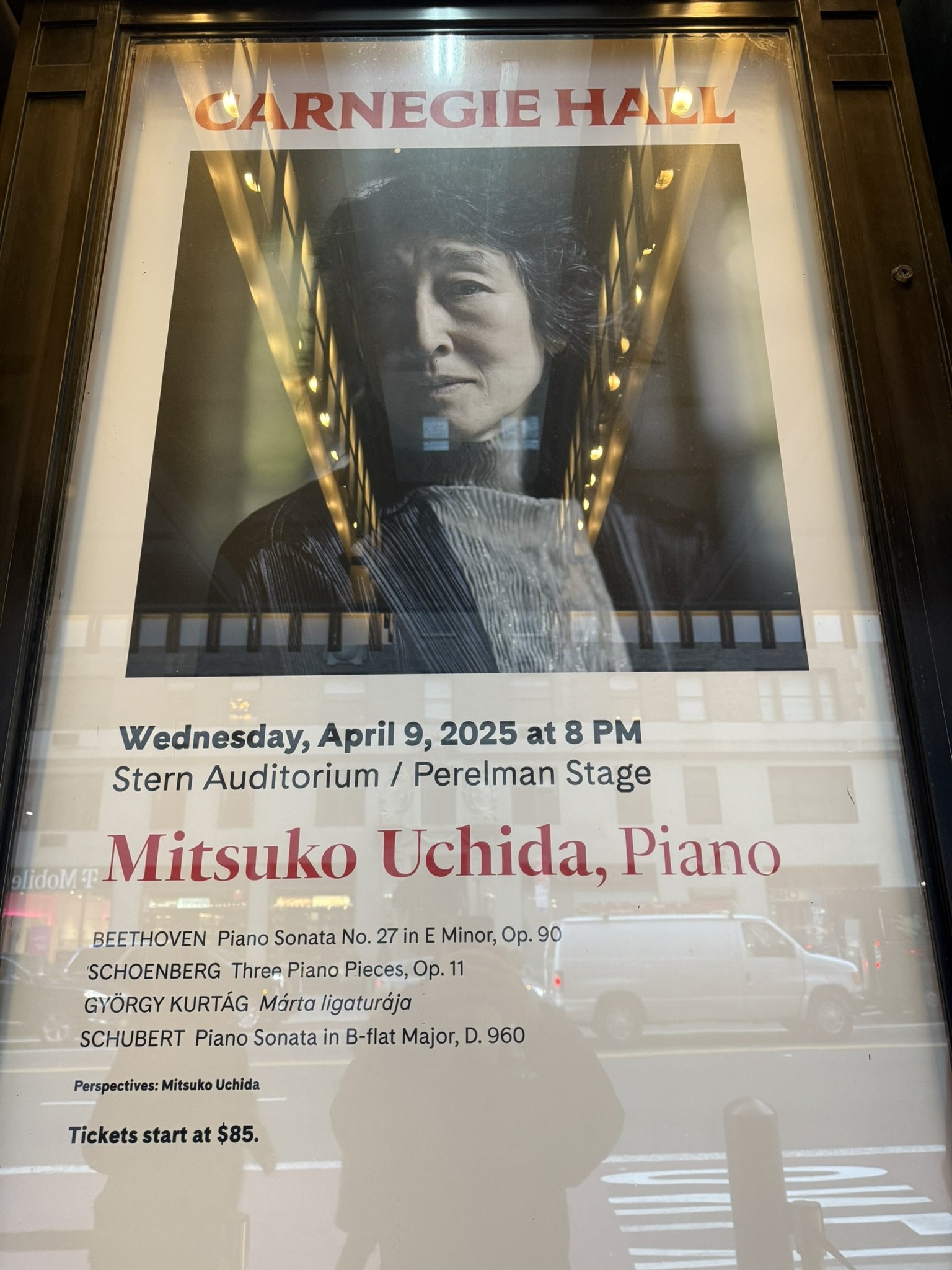Mitsuko Uchida had a piano recital at Carnegie Hall on April 9th. The program began with Beethoven's Piano Sonata Op.90. It was published in 1814, four years after his previous work, and was written in his 40s in a slump. It consists of two movements, and Beethoven notes that the first movement is a "battle between the head and the heart," and the second is a "conversation with a lover." The sharp contrast of dynamics at the beginning, which became the axis of her subsequent creations, depicts destruction and creation with deep concentration and a calm tempo. In the second movement, she unfolds various stories with a masterful touch on a theme that appears many times. The following three piano pieces, Op.11 by Schoenberg, are early atonal music written in 1909, in which old and new elements coexist in unresolved tension. Schoenberg said we must pursue a "style in which the necessities of technique and structure are realized without unnecessary expansion, and all elements are functional." Feeling that the traditions and customs of the time did not apply to the people, Schoenberg created a new system and pioneered atonal music. Uchida first introduced this piece to Japan in the 1970s. Uchida delicately weaves in the scales and dynamics that seem to have a theme but go in an unusual direction, and you can feel the infinity and freedom that the romantic sensibility is moving towards modernism. This feeling is 100 years after Beethoven. The second half starts with a piece written by Hungarian Kurtág when his wife of 73 years passed away in 2019. After the chords that overlap in ecstasy as they are played slowly, Schubert's last sonata, D960 Allegro Moderato, begins without pause. From the membrane of sound that evokes the delicate and intimate activities of human beings born from Kurtág, who will be 100 years old next year, Schubert's piano piece was written a few months before his death. The melody was played with a fragile and delicate performance in which colors and shapes emerged gradually. The melody, repeated once more from the beginning, was Uchida's Schubert, full of the usual unadorned wisdom and clarity.
内田光子は4月9日、カーネギーホールでピアノリサイタルを開催した。プログラムはベートーヴェンのピアノソナタ作品90から始まった。前作から4年後の1814年に出版されたこの作品は、40代でスランプに陥っていた時期に書かれた。2楽章構成で、ベートーヴェンは第1楽章を「頭と心の戦い」、第2楽章を「恋人との対話」と表現している。その後、ベートーベンの創作の軸となる冒頭の鋭い強弱の対比は、深い集中力と穏やかなテンポで破壊と創造を描き出す。第2楽章では、幾度となく登場する主題を巧みなタッチで描き出し、様々な物語を展開していく。続くシェーンベルクの3のピアノ曲、作品11は1909年に書かれた初期の無調音楽で、新旧の要素が未解決の緊張感の中で共存している。シェーンベルクは「技術と構造の必然性が不必要な拡張なしに実現され、すべての要素が機能する様式」を追求すべきだと述べている。当時の伝統や慣習が民衆に当てはまらないと感じたシェーンベルクは、新たな体系を創造し、無調音楽の先駆者となった。内田は1970年代にこの曲を初めて日本に紹介した。内田は、主題があるようでいて異様な方向へ向かう音階と強弱を繊細に織り交ぜ、ロマン派の感性がモダニズムへと向かう無限性と自由さを感じさせる。それはベートーヴェンから100年後の感覚だ。後半は、ハンガリー出身のクルタークが2019年に73年間連れ添った妻を亡くした際に書いた作品で始まる。恍惚として重なり合う和音がゆっくりと演奏された後、シューベルト最後のソナタ、D960 アレグロ・モデラートが途切れることなく始まる。来年100歳を迎えるクルターグから生まれた、人間の繊細で親密な営みを想起させる音の膜から、シューベルトが死の数か月前に作曲したピアノ曲が続く。そのメロディーは、色彩と形が徐々に浮かび上がってくる、儚く繊細に奏でられる。そして、冒頭から再び繰り返される演奏は、いつもの飾らない叡智と透明感に満ちた内田のシューベルトだった。
Mitsuko Uchida, Piano
Program
BEETHOVEN Piano Sonata No. 27 in E Minor, Op. 90
SCHOENBERG Three Piano Pieces, Op. 11
GYÖRGY KURTÁG "Márta ligaturája"
SCHUBERT Piano Sonata in B-flat Major, D. 960


